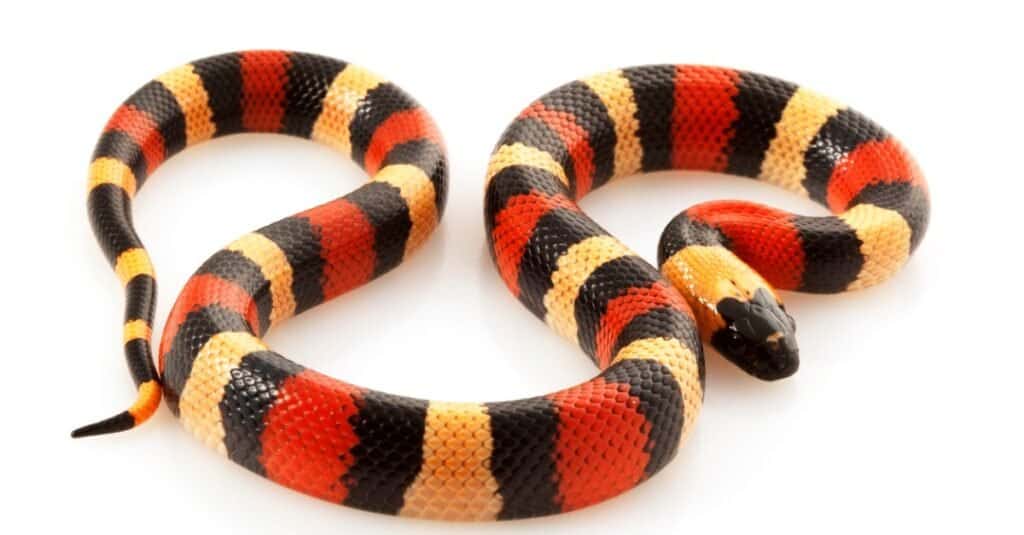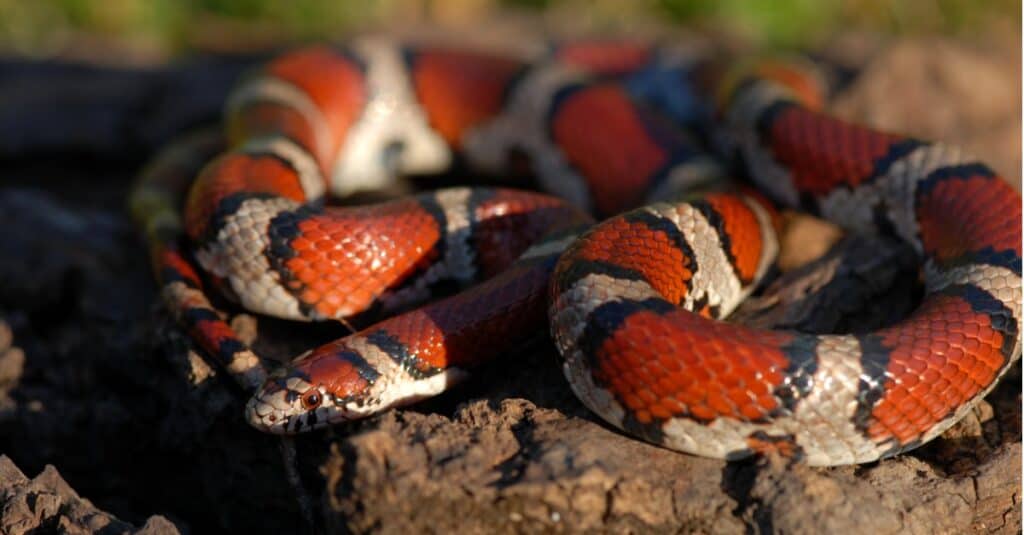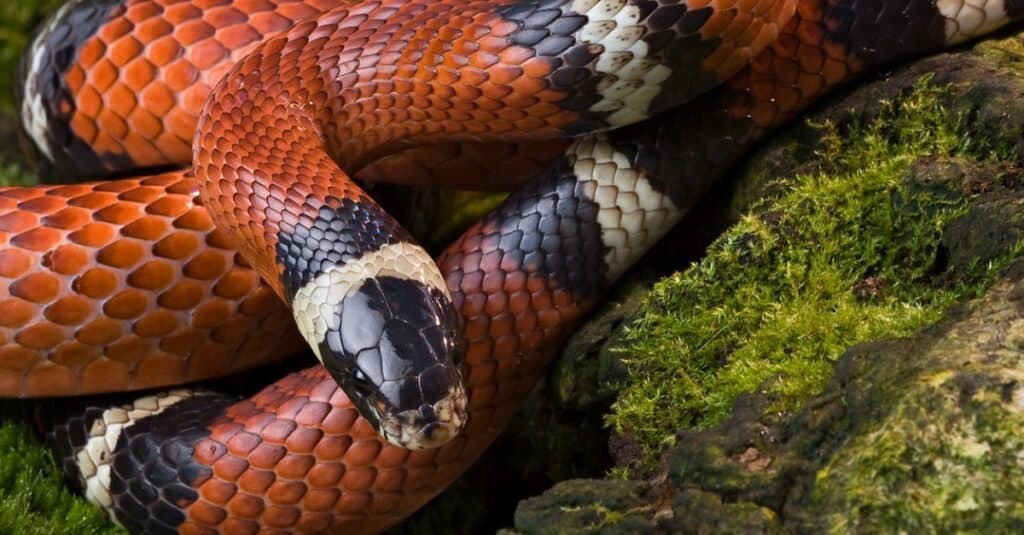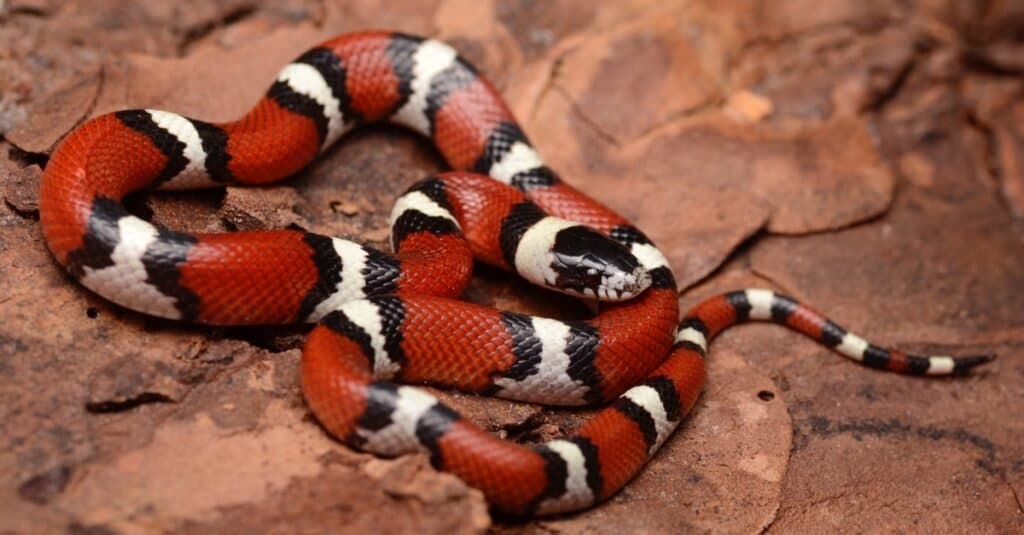
Milk snakes have a similar appearance to coral snakes
©iStock.com/amwu
Kingsnake Lampropeltis Triangulum, also known as the milk snake, has twenty-four recognized subspecies. It is possible to find milk snakes from the southernmost tip of Canada to the eastern half of the United States.
During the summer months, milk snakes are nocturnal. They like to stay on the ground, where they can blend in with the vegetation. They are, nonetheless, capable of climbing and swimming. However, these snakes prefer to stay hidden and out of the way.
Are these creatures, however, a threat to anyone who enters their domain? Let’s find out!
Are Milk Snakes Dangerous?

There are 19-23 rows of scales on every milk snake.
©iStock.com/Shoemcfly
Milk snakes are often mistaken for copperheads or coral snakes, but they pose little danger to humans. In fact, escaping is usually the first course of action taken by a milk snake when threatened. Milk snakes are slow-moving until they are frightened.
Milk snakes are not dangerous compared to other snakes. Although they lack a rattle in their tails and aren’t venomous, if caught or harassed, they may strike aggressively and vibrate their tails. Because of their popularity, these animals may readily be bred in captivity.
Are Milk Snakes Poisonous?

The Peublan milk snake is often mistaken for the coral snake.
©iStock.com/David Kenny
Milk snakes are not poisonous. However, it can be mistaken for a variety of species, including a deadly Agkistrodon and Sistrurus snake, because of its colors. In fact, because of their resemblance to the deadly pygmy rattlers, milk snakes are often killed. They often get confused with the coral snake as well.
Distinct species of snakes have different poisonous properties. The milk snake’s reputation has been tarnished because of this. Fortunately, there is no big threat to this breed.
Venomous vs. Poisonous

Milk snakes are neither venomous nor poisonous.
©iStock.com/wScottLoy
Toxin delivery is the only distinguishing factor between a toxic snake and a venomous snake. Poison and venom are both dangerous compounds. The term “toxic” is used to describe something that can affect your health. Venom is a toxin that is injected directly into the body, such as those found in a snake’s fangs.
Venomous: Venom is a toxin that is injected into the body by a bite or sting.
Poisonous: Poison is a toxin that enters the body via inhalation, ingestion, or skin absorption.
Snakes are venomous because the toxin is introduced into our system by their fangs. In addition, snake venom doesn’t typically cause injury if eaten — the only way it causes damage is by injection. While it’s possible for an animal to be both venomous and poisonous, it’s extremely rare in snakes.
The milk snake is neither venomous nor poisonous. It is a mild member of the snake family.
Do Milk Snakes Make Good Pets?

Milk snakes make good pets since they are non-venomous and docile in nature.
©Siarhei Kasilau/Shutterstock.com
Milk Snakes are ideal pets since they are little, non-venomous, colorful, and easy to manage. They are shyer when young but mature into docile and amiable creatures. Milk snakes are not venomous; thus, they are not a major threat. Keep them out of tiny children’s grasp until they are more comfortable around humans.
Milk snakes are among the most popular reptile pet breeds. Their eye-catching red and yellow bodies with black and white rings capture the attention of many. A milk snake is a terrific addition to any snake lover’s home or a great first pet for those willing to put in the time and effort to care for one.
Types of Milk Snakes

Louisiana Milk-snake found after a fall cold front blew through southeast Texas. The common name “milk snake” originated from the false belief that these snakes milked cows.
©TheTexasNaturalist/Shutterstock.com
If you are in the market for a pet milk snake, you’ll find more than a few varieties to choose from.
Here are the top 5 most common milk snake breeds:
Black Milk Snake: A typical length is between 4 and 6 feet. By adulthood, they have deep brown or all-Black skin, rather than the typical yellow, black, and red.
Red Milk Snake: On the pet market, these are commonplace. They grow to a maximum of three feet in length, are voracious eaters, and have redheads.
Central Plains Milk Snake: These creatures are smaller than most, reaching a maximum length of two feet. As adults, they can’t consume anything larger than a pinky mouse.
Honduran Milk Snake: Growing up to four feet long, the Honduran Milk Snake is by far the most widely available milk snake.
Nelson’s Milk Snake: Three to four feet in length is about average for this species, which is known for its yellowish-white rings, thick red rings, and thin black rings.
How Long Do Milk Snakes Live?

Milk snakes live between 11 and 14 years on average.
©Seregraff/Shutterstock.com
Milk snakes in captivity can expect a lifespan of between 12 and 14 years. Some milk snakes even make it to the age of twenty-one! In nature, they only live approximately 11 years. Just be mindful of the time and effort this pet may require of you.
The photo featured at the top of this post is © Seregraff/Shutterstock.com
Discover the "Monster" Snake 5X Bigger than an Anaconda
Every day A-Z Animals sends out some of the most incredible facts in the world from our free newsletter. Want to discover the 10 most beautiful snakes in the world, a "snake island" where you're never more than 3 feet from danger, or a "monster" snake 5X larger than an anaconda? Then sign up right now and you'll start receiving our daily newsletter absolutely free.
FAQs (Frequently Asked Questions)
How Did Milk Snakes Get Their Name?
It has been suggested that the name “milk snake” comes from the snakes’ habit of latching onto cows and sucking milk from their udders. Even though it has been demonstrated to be impossible, this is still a widely held misconception. In fact, it is the white rings and their proximity to cows that may have prompted the name.
Thank you for reading! Have some feedback for us? Contact the AZ Animals editorial team.






